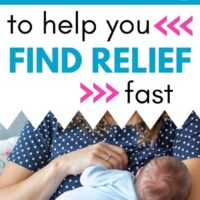This post may contain affiliate links, meaning I may earn a commission for recommending products. Read my disclosure policy for more info.
Breast engorgement is when a woman’s breasts literally become too full of milk.
And it’s not selective of new mothers either.
This can happen to any woman who has a child, even if it is her fourth baby.
When this happens, the breasts may become swollen, feel hard or heavy, and painful to the touch.
Breast engorgement can certainly make you feel uncomfortable– But the good news is that this condition is normal and be easily treated on your own at home.
What causes breast engorgement?
There are several possible reasons for having engorged breasts.
By pinpointing the causes for your engorgement, you can help alleviate your symptoms and hopefully prevent it from happening again.
1. The birth of your baby
Breast engorgement often happens after the birth of your baby.
Your body is beginning to produce milk to feed your little one, and until the regular feeding schedule is routine, your breasts could be making excess milk.
At this point, your body is not sure how much milk your baby will need, so it produces as much milk as it can to ensure you have enough to feed your baby.
Solution:
Feeding your baby often will help release milk and get your body used to a feeding routine as you both adjust.
2. Baby refuses to breastfeed
It has happened that some babies will refuse to breastfeed. Sometimes they will have problems latching or cannot feed due to a medical issue.
If this is the case, you may have to eliminate some engorgement until your body adjusts to not feeding your baby and your milk supply decreases.
Solution:
You can try several methods to help release any extra milk your body is producing, from pumping, hand expressing, or taking medication to help dry up your milk supply if you know you will not be breastfeeding.
3. Missed feedings
If you have missed any feedings with your baby, your body will still produce the milk you need to feed your little one.
Absent feedings can happen if you have supplemented your baby with a bottle instead of breastfeeding them directly, or they begin to sleep longer, therefore skipping a feeding or prolonging the times you feed your baby.
The milk will sit in your breasts since your scheduled feedings have previously required milk.
Solution:
If you know that you will be missing a feeding, try pumping or hand expressing the milk during the regularly scheduled time. You can help avoid any painful engorgement for missed feedings this way.
If your baby has missed a feeding and you are now dealing with engorgement, try to express some of the milk out to help lessen some of the fullness you are experiencing.
4. Cluster feeding
When babies go through a growth spurt, they will cluster feed. This simply means they require many feedings more frequently.
After your baby stops cluster feeding, your body has become accustomed to feeding more often and will continue to produce the same amount of milk, which can also cause engorgement.
Related: What Is Cluster Feeding and How Can Mothers Cope?
Solution:
As your body adjusts to the new feeding schedule, your breasts will also begin to change how much milk they produce.
Try pumping or expressing a small amount of milk to reduce any pressure or firmness, but not too much milk. Otherwise, your body will assume your baby is still feeding regularly and will continue to produce the same amount of milk.
5. Weaning or stopping breastfeeding
If you have decided to wean, stop breastfeeding, or cannot feed your baby any longer, your breasts can become engorged.
Your body will continue to make milk for a short amount of time until it becomes used to not feeding and will naturally adjust.
Solution:
It will take some time for your body to stop producing milk.
To help eliminate engorgement, again, you can pump or manually express a small amount of milk. Remember, you do not want to drain your breasts completely or your body will continue to make more milk.
Related: Baby-Led Weaning: Everything You Need to Know
Remedies for breast engorgement
When you are dealing with breast engorgement, you will want to try and relieve the pressure or pain as quickly as you can.
It is a very uncomfortable situation, and if you do not deal with the engorgement, you could be facing other serious problems, including blocked milk ducts or mastitis.
Thankfully, there are quite a few natural remedies to help you get relief.
1. Pumping
You can use a manual or electric breast pump to express some of the milk from your breasts. Pumping will release the extra milk that is causing engorgement.
It could be hard at first to get a breast pump to sit on your breasts if they are too engorged. You may need to try a different sized cup if your breasts are very engorged and do not fit properly.
2. Hand expressing
Often with engorged breasts, a manual or electric pump will not fit well due to the swelling. You can help eliminate this fullness by hand expressing and massaging the breasts to encourage some milk release.
Support your breasts with your hand and place your thumb at the top of your breast. Gently press your breast towards yourself and move the thumb down towards the nipple. This will encourage the milk to come down and, hopefully, relieve some pressure.
3. Warm compress or warm shower
Some women have found that a warm compress or warm shower will bring on milk flow. Sometimes placing a heating pad or warm compress on engorged breasts will help encourage milk flow to relieve some pressure without expression.
If you are not concerned with saving any expressed milk, try taking a warm shower to see if this helps drain some of the extra milk from your breasts.
4. Cabbage leaves
One old method that women have tried for years is cabbage leaves.
It may sound a little strange, but many mothers swear by this natural way to help reduce breast engorgement.
Place clean, chilled cabbage leaves on the breasts inside a loose-fitting bra so that they do not move around. Leave the nipples uncovered. Once the leaves begin to warm up (after approximately 20 minutes), discard the cabbage leaves.
You can use the cabbage leaf method up to three times a day to help eliminate engorgement.
If you are still experiencing painful breast engorgement, you can try another solution listed here or contact a lactation consultant or medical professional.
5. Feed baby on both sides
Some babies will completely drain one breast during feeding times and then become full and will not feed on the other side. This feeding pattern can lead to painful engorgement.
Try feeding your baby on both sides to help eliminate milk evenly so that your breasts do not become engorged between feedings.
6. Take Ibuprofen
Ibuprofen is usually a safe and effective over-the-counter medication to help relieve any pain associated with breast engorgement.
If you have any questions or concerns, please talk to your doctor before taking any new medication.
Problems that can occur from breast engorgement
If you ignore any symptoms of breast engorgement, it can lead to more pressing problems, including blocked milk ducts or mastitis.
1. Blocked milk ducts
When you have blocked milk ducts, there is a blockage of the duct inside the breast that carries milk to the nipple.
This condition can happen if there is not adequate draining if milk from the breast, so it consequently builds up. This buildup can cause pain, swelling, pressure, and even a lump in the breast tissue.
2. Mastitis
Mastitis is an infection in the breast that can be caused by milk sitting in the ducts for too long, or blocked milk ducts that do not allow adequate draining. Mastitis is a serious condition if it is left untreated when signs or symptoms occur.
A woman may see red or swelling of the area or even red lines that follow at blocked milk duct. Mothers may have a fever, or show flu-like symptoms, or feel extremely tired. If untreated, an abscess can happen.
When to get help
Even though you can remedy breast engorgement on your own, there are times when you need the help of your medical practitioner or lactation consultant.
Engorgement is normal and can happen for a few different reasons, but there can be instances where it indicates a more significant condition.
If you have any symptoms including:
- Fever
- Extremely tired or run-down
- Flu-like symptoms
- Continuous engorgement after several days of trying various methods
- Lumps
- Redness of breasts
- Swelling in a localized area of the breast
- Painful lumps in the breast tissue
- Inability to express milk
- Repeated mastitis or blocked ducts
Moms may experience any of these symptoms with their first child or subsequent children. It is essential to know what to look for with breast engorgement and get the help you need before the problem becomes severe.
Early intervention of any engorgement symptoms will keep you and your baby healthy and happy during feedings!


